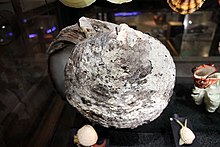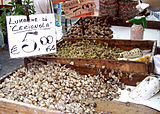Pinctada maxima
This article needs additional citations for verification. (September 2014) |
| Pinctada maxima | |
|---|---|

| |
| Pinctada maxima | |
| Scientific classification | |
| Kingdom: | |
| Phylum: | |
| Class: | |
| Order: | |
| Family: | |
| Genus: | |
| Species: | P. maxima
|
| Binomial name | |
| Pinctada maxima (Jameson, 1901)
| |
Pinctada maxima is a species of pearl oyster, a marine bivalve mollusk in the family Pteriidae, the pearl oysters. There are two different color varieties: the White-lipped oyster and the Gold-lipped oyster.
These bivalves are the largest pearl oysters in the world. They have a very strong inner shell layer composed of nacre, also known as "mother of pearl". They are important in the cultured pearl industry as they are used to produce South Sea pearls.
Known also as the South Sea Pearl or Philippine Pearl, it was declared by Philippine President Fidel Ramos as the national gem in 1996 through Proclamation No. 905.[1] This is also featured at the reverse side of the PHP 1000 bill.
Distribution

This species occurs in Australia, Fiji, Tahiti, Indonesia and the Philippines.
Description
Pinctada maxima oysters grow very large, up to 12 inches in diameter. The two color varieties have different coloration in the outer edge of the interior. This mother of pearl or nacre is responsible for the color of the pearls that the oyster can produce. Water temperature, plankton and sediments determine which color variety is more common in a given area.
Pearl farming
Pinctada maxima is the only species that produces South Sea pearls. Currently south sea pearls are cultured primarily in Australia and Tahiti. Because these pearl oysters are so large, a much larger nucleus than usual can be used in culturing.
References
- ^ "Philippine Fast Facts, National Gem: Philippine Pearl". National Commission for Culture and the Arts. Retrieved 2013-02-20.
External links
![]() Media related to Pinctada maxima at Wikimedia Commons
Media related to Pinctada maxima at Wikimedia Commons


